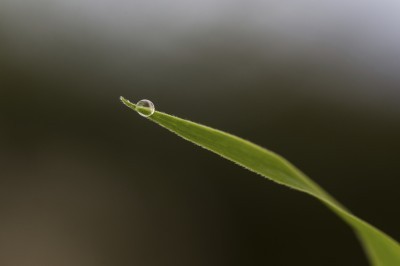






Guttation is the appearance of little droplets of liquid on the leaves of plants. Some people notice it on their houseplants and expect the worst. Although unsettling the first time it happens, guttation in plants is completely natural and not harmful. Keep reading to find out more about causes of guttation.
Plants gather a lot of the moisture and nutrients they need to survive through their roots. In order to move these things upward, the plant has tiny holes in its leaves called stomata. Evaporation of moisture through these holes creates a vacuum that pulls water and nutrients in the roots up against the pull of gravity and throughout the plant. This process is called transpiration.
Transpiration stops at night when the stomata close, but the plant compensates by drawing in extra moisture through the roots and building up pressure to force nutrients upward. Day or night, there is constant motion inside a plant. So when does guttation occur?
The plant doesn’t always need the same amount of moisture. At night, when temperatures are cool or when the air is humid, less moisture evaporates from the leaves. However, the same amount of moisture is still drawn up from the roots. The pressure of this new moisture pushes out the moisture that is already in the leaves, resulting in those little beads of water.
Occasionally, guttation is confused with dew drops on outdoor plants. There is a difference between the two. Simply put, dew is formed on the plant’s surface from condensation of moisture in the air. Guttation, on the other hand, is moisture emitted from the plant itself.
Most people’s gut reaction is that guttation is a sign of overwatering. While it could be, it is also a sign of a perfectly healthy plant, so you shouldn’t cut down on watering if you notice it.
Guttation in plants can really only be harmful if you are over-fertilizing. If this is the case, minerals from the fertilizer can build up over time on the leaf tips and burn them. If you notice small white deposits on your leaf tips, you should cut down on your fertilizing.
Gardening - What Are the Benefits?
The Winter Greenhouse ?What to Grow
Gardening - What Are the Benefits?
What Is A Root Zone: Information On The Root Zone Of Plants
What Is Phototoxicity: Information About Phototoxicity In Plants
Common Edible Plants: Learn About Edible Plants That Grow In The Wild
Learn About The Pollination Process And Plants That Need Pollinators
Learn About Fertilization For GreenHouse Plants
Learn About The Different Types Of Roses
What Plants Grow in the Desert Biome?
What are the Benefits of Hydroponic Gardening?
What Is A Master Gardener: Learn About Master Gardener Training
Windowless Houseplants: Learn About Using Plants For A Windowless Room
What Is Bottom Watering: Tips On Watering Potted Plants From The Bottom
Copyright © www.100flowers.win Botanic Garden All Rights Reserved